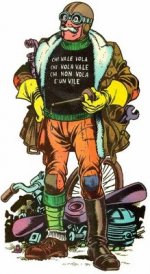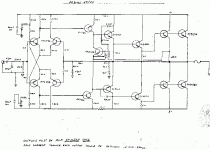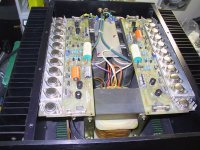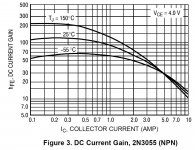Attachments
Not sure that a Bedini is going to be terribly useful if those Apogees are one's that have the extremely low Z design... it is more or less a function of the size of the PS and the number of output devices that will govern the ability to drive very low Z loads...
I've repaired Strellioff amps, he was Bedini's partner at one time, but I never bothered to fully trace the circuit out.
Nothing special, iirc...
_-_-bear
I've repaired Strellioff amps, he was Bedini's partner at one time, but I never bothered to fully trace the circuit out.
Nothing special, iirc...
_-_-bear
bear said:Not sure that a Bedini is going to be terribly useful if those Apogees are one's that have the extremely low Z design... it is more or less a function of the size of the PS and the number of output devices that will govern the ability to drive very low Z loads...
I've repaired Strellioff amps, he was Bedini's partner at one time, but I never bothered to fully trace the circuit out.
Nothing special, iirc...
_-_-bear
tnx bear ;
I already saw that Strelliof on your site ;
I'll pass further info you gave me .
Original spec on 803 was 52 pounds (less than 25kg). There is no way that it could be biased for more than about 10W in pure class A, if that. I think your buddy should look at KMA160 or KMA200, they are proven performers with current hungry Apogees. Even old KSA100 will be vastly better choice.
My aussie 2c (about 0.0001 euro )
)
be warned - his aircondition bills will skyrocket ! Good for winter though ...
My aussie 2c (about 0.0001 euro
be warned - his aircondition bills will skyrocket ! Good for winter though ...
I talked with Bedini many years ago and they won't give out the BA-803 schematic. As I understand it. it is a single ended sliding bias class-A is what i was told. I owned a BA-803 and wish i had never given it up! at the time, my speakers just didn't really show off what that amp could do. I had Vandersteen 2c's at the time and while good speakers, that amp deserved better. I have been looking for an 803 for many years now and they are not easy to find.
Zc
Zc
no sliding bias in the 25/25...
I think that in order to have sliding bias there must be two additional small signal transistors used for sensing? I can't see them in the photo of the PCB.
Bedini 250/250 Mk II Heat dissipation
I have one of these, as well as a 150/150 Mk II . The 150 has been my favorite between the two but now needs repairs and so I put the 250 back in my system. Once again I realized that despite its size, and twice the number of outputs, the 250 can't achieve as high detail and smoothness at the same levels as the 150. Checking for heat distribution on the fins, I see that the front fins run much warmer than the mid and rear ones. Looking at the outputs' placement on the heat sinks, this an be explained by the fact that the devices are not centered on the heat sinks but installed to the front of the box, so effectively half of the outputs get one third of the fins (at the front of the box) and the other half get twice as much heat sinking. So, temperatures at the front of the sinks are typically 35-40 degrees higher than the rear. The 150, on the other hand, has the devices centered on the heat sink and temperatures don't vary as much. The 803 which is the later iteration of the 250 also has its outputs centered on the fins assembly. The 250 also has the worst specs of all Bedini amps in the spec sheets I found online, and it is the only one I have seen in pics online, where the outputs are not centered on the heat sinks. Could that explain the difference in sound? Can two transistors running at 30-40 degrees (F) differential create an audible mis-match? Would the system benefit from centering the outputs and placing them on a heavier extruded sink rather than the thin bent aluminum fins the stock amp has?
I have one of these, as well as a 150/150 Mk II . The 150 has been my favorite between the two but now needs repairs and so I put the 250 back in my system. Once again I realized that despite its size, and twice the number of outputs, the 250 can't achieve as high detail and smoothness at the same levels as the 150. Checking for heat distribution on the fins, I see that the front fins run much warmer than the mid and rear ones. Looking at the outputs' placement on the heat sinks, this an be explained by the fact that the devices are not centered on the heat sinks but installed to the front of the box, so effectively half of the outputs get one third of the fins (at the front of the box) and the other half get twice as much heat sinking. So, temperatures at the front of the sinks are typically 35-40 degrees higher than the rear. The 150, on the other hand, has the devices centered on the heat sink and temperatures don't vary as much. The 803 which is the later iteration of the 250 also has its outputs centered on the fins assembly. The 250 also has the worst specs of all Bedini amps in the spec sheets I found online, and it is the only one I have seen in pics online, where the outputs are not centered on the heat sinks. Could that explain the difference in sound? Can two transistors running at 30-40 degrees (F) differential create an audible mis-match? Would the system benefit from centering the outputs and placing them on a heavier extruded sink rather than the thin bent aluminum fins the stock amp has?
I put the 250 back in my system. Would the system benefit from centering the outputs and placing them on a heavier extruded sink rather than the thin bent aluminum fins the stock amp has?
1) The output transistors are sometimes mounted on an angle to reduce the required length of the heatsink mounting tab. If they were mounted "straight" the effective length required for the heatsink "shelf" is longer. A larger heatsink could gain some maximum power benefits(more ClassA power), but will have no effect on the low level sound quality. Personally, I would not waste money or time here.
Mounting TO-3 packages on an angle can also allow two parallel PCB traces since the angle horizontally-skews the base and emitter pin alignment.
2) If your 250 is a Quasi Complementary output like the earlier attached Bedini 25_25 (#11) using NPN 2N3055 pull-ups and NPN 2N3055 pull downs, then this is likely the sonic quality limiting circuit. Can you easily open your amp and check if all outputs are 2N3055 in TO-3 metal packages?
3) The sliding Vbe bias circuit in the Bedini 25_25 schematic can also cause sonic problems because the output has a direct, and non-symmentrical connection to the bias circuits. No modern amp uses this circuit.
A LARGE effort in changing the output to a NPN + PNP push pull circuit, with a modern Vbe multiplier bias circuit that makes a smooth transistion from ClassA to ClassAB bias would be the only investment likely to have major sonic improvements. Naturally, you would also replace the power electrolitic caps at this time.
I attached a simple dual diff input schematic I had laying around as a typical NPN-PNP push-pull output with a typical Vbe multiplier to give you some idea of the complexity of changing your circuits.
Attachments
Thanks for the response, LineSource. But the question may have been misunderstood. The problem is that the "shelf" is not centered on the heat sink. The 10" or so long shelf is mounted all the way to the front of the 15" or so long heat sink. This gives the outputs at the very front (physical position on the heatsink) about 9 sq inches of heat sink real estate (excl fins) while those at he very back of the amp have about 36 sq inches. This major difference in cooling capacity causes a corresponding difference in the operating temperatures of the two (quasi) halves. The difernce is very obvious to the touch and during a measurement under normal oeration the outside of the fins reached 120 deg F appr where the furthest front ouput is, vs 85 degrees near the furthest rear transistor. So, the outputs at the two ends of the amp work at very different temperatures. Would that cause enough of a mis-match between the outputs to be audible?
The difference is very obvious to the touch and during a measurement under normal oeration the outside of the fins reached 120 deg F appr where the furthest front ouput is, vs 85 degrees near the furthest rear transistor. So, the outputs at the two ends of the amp work at very different temperatures. Would that cause enough of a mis-match between the outputs to be audible?
The chassis construction in post #11 does not show the poor cooling design that your amp apparently has.
If your temperature measurements are accurate, an 85C vs. 35C temp difference will have a measurable increase in distortion. The attached graph shows the variation in hfe gain vs. temp for the 2N3055. A 50C variation will change hfe gain by 30%. From my experience, your amp with a 50C variation has a very poor cooling design that will affect sound, reliability and possibily stability.
If the designer used a large value (0.68 - 1 ohms) emitter resistor in each output, he may have acceptanced poor performance to use the low cost thermal design.
I do not know if the sliding Vbe bias circuit shown in the Bedini 25_25 is also used in your amp, and if the designer uses this circuit in some way to reduce temperature generated distortion effects.
If you put the work and money into improving the heatsink design, the circuit topology (quasi complementary with NPN 2N3055 pull-up and NPN 2N3055 pull-down) would, in my opinion, still be the major sonic performance limiter. Without a chassis picture and schematic of your amp it is hard to give great advice.
Attachments
- Status
- This old topic is closed. If you want to reopen this topic, contact a moderator using the "Report Post" button.
- Home
- Amplifiers
- Solid State
- Bedini 250W ?






